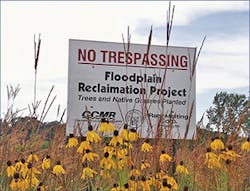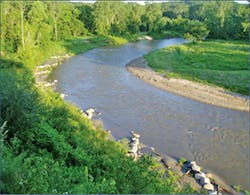Pollutant Trading to Improve Riparian Habitats
Rahr Malting Co., located in Shakopee, MN, is one of the largest malt producers in the United States. In 1997, Rahr requested permission to build its own wastewater treatment plant and withdraw from the regional sewer system. The Minnesota Pollution Control Agency (MPCA) denied this request because a total maximum daily load (TMDL) established in 1988 had allocated the entire available discharge load for the lower Minnesota River to existing treatment facilities. To solve the regulatory deadlock, an innovative permit was developed by Rahr and the MPCA that allowed trading between point and nonpoint sources of pollution.
Pollutant Trading
Pollutant trading, to address regional air-quality non-attainment, was proposed in the early 1990s for air emissions sources to voluntarily reduce emissions and “sell” trading credits to other sources. This made it economically desirable for an industry to clean up its emissions sources by more than the current air-quality emissions standards, thereby contributing to attainment of the ambient air standards in the non-attainment airshed. This type of trading is considered point-point trading.
Under the federal Clean Water Act, the EPA established the regulatory framework in the National Pollutant Discharge Elimination System (NPDES) program to protect and clean up the nation’s waters. The EPA and the delegated states had the authority to regulate both point and nonpoint sources of pollution through the NPDES permit program. During this period, point sources, or direct discharges of wastewater, were highly regulated through NPDES permits. On the other hand, nonpoint sources (diffuse area-wide sources) were not regulated. Instead, financial assistance to states was provided to develop and implement programs to control nonpoint sources.
Regulators in Minnesota, particularly the author Curtis Sparks, former manager of the water-quality Program Development Section at the MPCA, came to the realization that point-source controls were not enough to address the impaired waters of the Minnesota River. Recognizing that water-quality management is a watershed problem and that both point and nonpoint sources are contributors to the overall impairment of the nation’s waters, he asked why states shouldn’t look at each one as a controllable source and allow trading of the regulated point sources with the then-unregulated nonpoint sources.
Although Sparks left to become a private consultant in 1990, others continued to believe that pollutant trading was a good concept. In 1995, under President Clinton’s re-inventing of environmental regulations, the EPA issued a policy statement on effluent trading. Water-based pollutant trading, similar to air emissions trading, was introduced in 1996 to clean up the nation’s waters through reductions in point and nonpoint sources. The trading question was finally answered in 1997 when the MPCA issued Rahr Malting Co. an NPDES watershed-trading permit.
Rahr Malting Co.
In 1993, Rahr Malting Co. engaged Sparks and his team to help it obtain a permit to discharge to the Minnesota River. Rahr’s request for a discharge of 150 pounds per day (68 kilograms per day) of carbonaceous biological oxygen demand (CBOD5) was first denied because, in the 1988 Minnesota River Load Allocation Study, the entire TMDL was allocated to existing dischargers. Even with treatment upgrades to existing point sources, it was projected that the Minnesota River would not meet water-quality standards. It was clear that an aggressive approach was needed that far exceeded an equal trade of pollutants from existing nonpoint sources for an allocation of 150 pounds per day of CBOD5.
Rahr’s new proposal took a very conservative approach to calculating the reduction of pollutants from nonpoint-source projects so that the resulting compensation ratio was 2 pounds of pollutant reduction for each pound discharged under the NPDES permit. The proposal took into account multiple pollutants (CBOD5, phosphorus, nitrogen, and sediment) that contribute to the dissolved oxygen impairment in the Minnesota River. The belief of the MPCA regulators in watershed-based management and the EPA policy statement supported Rahr’s approach to obtaining self-sufficiency in its management of wastewater. In the next three years of stakeholder negotiations, one of the most comprehensive pollutant trading projects was created and subsequently implemented using the four best management practice (BMP) projects described as follows.
The NPDES Trading Permit
Under the agreement with the MPCA, Rahr agreed to offset its discharge of 1.5 million gallons per day with 150 pounds per day of CBOD5. Nitrogen and phosphorus were also limited. The resulting trading permit is unique in that it allowed Rahr to trade not only CBOD5, but also other nonpoint-source pollutants that negatively affect the water quality of the Minnesota River. Rahr was allowed to trade nitrogen, phosphorus, and sediment reductions for CBOD5 credits.
Rahr’s current discharge to the Metropolitan Council Environmental Services Blue Lake treatment plant would be removed and the allocation of load to the Blue Lake plant would not be reduced, making the capacity available for future residential growth in the region. One trading credit was worth 1 pound of CBOD5. A complicated derivation of trading ratios was devised to provide “equivalency” between point- and nonpoint-source loadings. Rahr accepted a phosphorus limit of 2 milligrams per liter instead of the standard 3 milligrams per liter. In addition, Rahr agreed to spend $250,000 on CBOD5 nonpoint-source reductions. The funds were to be spent on achieving the 150 credits with BMPs to be approved by the MPCA.
Rahr established a five-member board to administer the trust fund. Members consisted of two Rahr Malting Co. representatives; the executive director of a local environmental group, the Coalition for a Clean Minnesota River (CCMR); the director of the Minnesota Board of Water and Soil Resources; a member of an environmental advocacy group, the Minnesota Center for Environmental Advocacy; and the president of North American Wetland Engineering (NAWE), which served as Rahr’s environmental consultant.
The MPCA identified general categories of BMPs, the majority of which involve the use of native riparian vegetation. These categories included soil erosion BMPs, livestock exclusion, rotational grazing, critical-area set-aside, and wetland treatment systems. Trading ratios were based on conservative estimates of their effectiveness. The phosphorus-to-BOD ratio was established at 1:8, and the eco-region mean estimates were closer to 1:17. The CBOD5 content of sediment was established at 0.5 pound per ton of soil. Nitrogen credits for livestock exclusion, soil erosion, and rotational grazing were reduced by 50% to account for possible ammonia volatilization as a “field loss factor.” Delivery ratios were provided for distance from the stream for erosion calculations. The time spent in the grazing area was reduced to 25% to 36% for nitrogen, phosphorus, and CBOD5 buildup calculations. For wetland treatment, the comparable design load reductions for sediment and nitrogen were reduced by 75% and 23%, respectively. In all, the trading calculations were considered conservative enough to result in a 2:1 trade for each proposed project. The Rahr permit has been widely cited as an example of a successful trading agreement (Environomics 1999; Kerr, Anderson, and Jaksch 2000; Fisher-Vanden et al. 2004).
Nonpoint-Source Trades
Under the terms of the Rahr permit, four projects were designed by the authors and implemented under the trading agreement. Nonpoint-source reduction projects are summarized in Table 1.
The process for each project consisted of identification of candidate projects. Many projects were nominated by CCMR and evaluated by NAWE for consideration. Preliminary credit and cost calculations were conducted and submitted to the MPCA for comments. Each project was brought to the trust fund board for approval. Final plans and specifications were submitted to the MPCA for project approval. Some projects were bid to private contractors for construction. The MPCA provided final review, granted 45% of the credits upon completion of construction, and granted the remaining credits upon completion and stabilization of the site.
Cottonwood and Minnesota River Sites
These two sites are located at the junction of the Minnesota and Cottonwood rivers near New Ulm, MN. Land clearing in the 1920s resulted in both sites being used for row crops (corn and soybeans). Without the protection of riparian vegetation, over 1.5 meters of sediment had been lost over a 42.5-hectare area due to flood events.
These sites were restored by planting cottonwood (Populus deltoides) tree cuttings in buffer strips along preferential floodwater paths. The remainder of the sites were seeded with warm-season, deep-rooted native perennial grasses, resulting in a matrix of Type 1 and Type 7 wetland habitats (Shaw and Fredine 1971). The resulting phosphorus reductions to the Minnesota River system were estimated to cost $4.89 USD per kilogram (Feng and Easter 2003), which is considered highly cost-effective, as reductions from municipal point sources have been estimated to cost between $8.81 and $39.68 USD per kilogram.
The sites were purchased from the landowners, BMPs were established, and the land was donated to the City of New Ulm. The planting was done in 1997 following approval of the project by the MPCA. The New Ulm community was involved in the planting along with representatives from Rahr, NAWE, and CCMR. Rahr provided maintenance of the sites until plants and trees were established. The sites have experienced several flood events with no visible damage, channelization, or sediment loss.
8-Mile Creek
Two of the river restoration sites–8-Mile Creek and Rush River–involved stabilizing eroding banks. At the 8-Mile Creek site, bank erosion was threatening a barn, and at the Rush River site, it was threatening a farmer’s house. The creek was advancing toward the feedlot and barn at a rate of approximately 8 feet per year. Both cattle exclusion and soil erosion credits were calculated for the site by NAWE and submitted to the MPCA for approval. Bank stabilization areas were planted with sandbar willow (Salix exigua) cuttings, and seeded with a switchgrass, big bluestem, and Indian grass seed mix. The riparian area along 8-Mile Creek was fenced off to eliminate cattle access. Natural revegetation is proposed for the riparian areas. Maintenance of the fence and the bank stabilization area is the responsibility of the landowner as defined in an agreement with Rahr Malting Co. A preliminary project budget was established at $12,000.
Bank stabilization procedures differed because of the different sizes of the streams involved. At the relatively small 8-Mile Creek site, a new bank contour was created using a combination of root wads and timber cribbing using locally harvested cottonwood (Populus deltoides) trees.
Rush River
At the much larger Rush River site, a bench terrace was constructed at the base of the eroding cliff face, and the stream power was diverted to the center of the channel using J-hooks (Rosgen 1996). Bank stabilization areas were planted with three rows of (DN34) hybrid poplar cuttings, at a spacing of one every 3 feet along the row. Plantings were done with dormant cuttings in the spring of 2000. Additional vegetation occurred due to suckering from the timber cribbing and natural colonization. Areas with less than 70% cover were planted with additional cuttings. Maintenance of the bank stabilization area is the responsibility of the landowner as defined in the agreement with Rahr Malting Co. The preliminary construction cost estimate was $48,000.
Credits were derived from reduction of sediment reaching the Rush River. Sediment reduction was determined based on volume lost in the bank erosion area. This was computed as a trapezoidal volume. The height of the trapezoid was the average bank height. The width of the trapezoid was based on historical aerial photography. The length of the trapezoid was the stretch of the bank stabilized by the project. All sediment was assumed to be delivered to the Rush River. After the project, no sediment is being delivered.
Credits were be derived from the nitrogen, phosphorus, and sediment loads. Nitrogen and phosphorus were determined based on site-specific soil sampling. Three soil samples were taken in the upper alluvium layer and three samples in the lower till to form a vertical transect. Two sampling transects were performed. The resulting mean concentrations of nitrogen and phosphorus were used for determining credits. The resulting phosphorus reductions to the Minnesota River system were estimated to cost between $4.96 and $5.82 USD per kilogram (Feng and Easter 2003).
Conclusions
Rahr Malting Co., in an effort to reduce its cost of treating wastewater and to stabilize its future cost, proposed to build its own wastewater treatment system and remove the discharge to the regional treatment system. In order to do so, a cooperative effort by Rahr, the MPCA, CCMR, and the Minnesota Center for Environmental Advocates, as well as other stakeholders, established a program that resulted in one of the first watershed pollutant trading permits in the nation. The permit was multipollutant and resulted in the construction of four nonpoint-source BMP projects.
The projects were completed, credits were granted, and the obligations for pollutant trading were accomplished. The actual trading credits were 212.8, which is over 30% more than the permit called for.
The four projects were completed and approved using native plant bioengineering techniques that were designed to improve riparian habitats. All of these projects demonstrate the water-quality improvements that result from using native vegetation in the riparian corridor. The projects completed demonstrated that a variety of trees, grasses, and wildflowers could be used to stabilize steams and riparian floodplain areas, depending on the frequency and duration of flooding. Pollutant trading, as carried out under the Rahr permit, demonstrated that reduction of nonpoint sources of pollutants was highly cost-effective when compared to control of conventional point sources.
References
Environomics. 1999. A summary of U.S. effluent trading and offset projects. A report prepared for Dr. Mahesh Podar, U.S. Environmental Protection Agency, Environomics, Inc.: Bethesda, Maryland, USA.
Feng F., Easter K.W. 2003. Pollution trading of offset new pollutant loadings – a case study in the Minnesota River Basin; Proceedings of the American Agricultural Economics Association Annual Meeting; Montreal, Canada.
Fisher-Vanden K., Breetz H.L., Garzon L., Jacobs H., Kroetz K., Terry R. 2004. Water quality trading and offset initiatives in the U.S.: A comprehensive survey, Dartmouth College: Hanover, New Hampshire USA.
Kerr R.L., Anderson SJ, Jaksch J. 2000. Crosscutting analysis of trading programs; case studies in air, water and wetland mitigation trading systems, National Academy of Public Administration: Washington DC, USA.
Minnesota Pollution Control Agency. 1997. National Pollutant Discharge Elimination System (NPDES) Permit MN 003197, Minnesota Pollution Control Agency: St. Paul, Minnesota USA.
Rosgen D. 1996. Applied River Morphology. Wildland Hydrology, Pagosa Springs, CO, USA.
Senjem, Norman. Pollutant Trading for Water Quality Improvement: A Policy Evaluation. Water Quality Division, Minnesota Pollution Control Agency. 1997.
Senjem, Norman. Case Study: Minnesota – Pollutant Trading at Rahr Malting Co. Environmental Regulatory Innovations Symposium, November 5-7 1997.Water Quality Division, Minnesota Pollution Control Agency.
Shaw S., Fredine C.G. 1971. Wetlands of the United States. Circular 39. U.S. Fish and Wildlife Service, Washington, D.C., USA.
U. S. Environmental Protection Agency. Draft Framework for Water Based Trading. Office of Water, EPA 800-R-96-001. Washington D.C. May 1996







